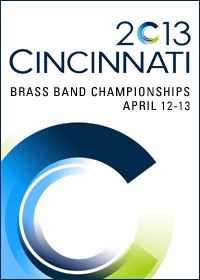The Music Bands play - Part 1
5-Jan-2009In a major new series of articles for 4BR, Paul Hindmarsh examines aspects of the brass band repertoire of the past 100 years.
Some of my earliest musical memories – going back half a century – are of the sound of the Cambridge Salvation Army Band playing hymn tunes and marches with my late father sitting on the end chair.
It’s hardly surprising then that in all the various musical avenues of my professional career in music – university, academic research, librarian, professional singing, the BBC – brass bands and especially the music they play have been a constant presence.
Artistic ambition
Coming to Manchester in the mid-1980s turned that ever present interest into a passion. But it was a specific interest that captured my imagination – undoubtedly associated with my role as a music producer for BBC Radio 3 – that of the artistic ambition of brass bands, allied to the development of the musical repertoire.
Culture
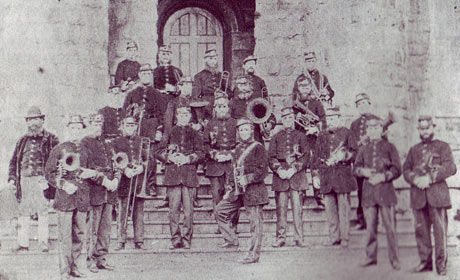
The Cyfarthfa Band of Merthyr Tydfil - the first great professional band?
The brass band culture, as we know sprang, to life in the 19th century as a manifestation of social conscience, patronage and not a little paternalism among the industrial and community leaders.
Mill owners like John Foster in Queensbury and the iron works ‘baron’ Richard Crawshay in Merthyr Tydfil both established brass bands.
John Foster was not alone in seeing it as a means of what we would term today social engineering. He and others set down brass roots in working communities throughout the country, that may have been disturbed over the subsequent decades, but which have continued to be propagated and sustained in some form ever since.
Bank rolling
To change metaphors Crawshay was the Abramovich of the Victorian era, establishing and personally bankrolling a unique brass band, at least to begin with. He sought out the finest brass players in the country, many of them professionals, brought them to Merthyr as the core of his Cyfarthfa Iron Works Band.
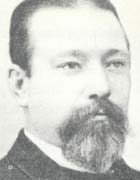 And then there were the community bands – like Besses o’ th’ Barn in north Manchester. This band’s motivation was self-improvement and musical ambition. It sustained itself through its success as a musical and competitive outfit, becoming in its heyday of the late 19th and early 20th centuries under Alexander Owen (right), the most famous brass band in the world.
And then there were the community bands – like Besses o’ th’ Barn in north Manchester. This band’s motivation was self-improvement and musical ambition. It sustained itself through its success as a musical and competitive outfit, becoming in its heyday of the late 19th and early 20th centuries under Alexander Owen (right), the most famous brass band in the world.
Pragmatic
Add to these the inspired pragmatism of the founder of the Salvation Army, William Booth – for whom the loud and stirring sounds of brass instruments became an indispensable part of his open-air evangelism – and you have the four most significant models that formed the brass band movement of the 20th century.
As we enter to 21st century the brass band community world-wide moves in very a different social climate. For many well-rehearsed reasons, it no longer attracts or keeps instrumentalists in the vast numbers it used to. However, there is one constant that the brass band movement sometimes appears to take for granted – and this is the music it plays.
I mentioned the models of Besses, Black Dyke and Cyfarthfa for one very good reason.
Distinctive
Their distinctive history is preserved in the musical documents they played from – a lot of which still survives in three unique collections. The library of Besses o’ th’ Barn is perhaps the least well preserved of the three – sadly – but all three provide a perspective on the past, which can be ‘read’ from the music, they performed.
Right from these early beginnings brass bands both entertained their audiences and honed their technical skills by competing. Concert repertoire was gleaned from many and varied sources – popular, operatic and, plus some fascinating original music.
The competitive obsession also took hold early, producing in the bands of some expert conductor/ arrangers like Owen and Gladney (below right) classical some monumental transformations of operatic masterworks.
Bespoke
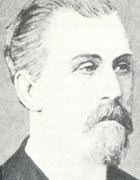 Much of this repertoire was bespoke – substantial portions of Rossini, Wagner, Beethoven even Berlioz etc – tailor-made to show-off the considerable skills of the players to best advantage.
Much of this repertoire was bespoke – substantial portions of Rossini, Wagner, Beethoven even Berlioz etc – tailor-made to show-off the considerable skills of the players to best advantage.
The historical perspective as seen through the Black Dyke and Cyfarthfa collections in particular would indicate that the shelf-life of much of this was not intended to be long. There were waves of new work produced to refresh the diet of concert music and produce contesting novelties to out-flank the competition.
Commercial advantages
Although much has changed in the way the music that brass bands play has been disseminated – the commercial advantages of published material really took hold towards the end of the 19th century as the number of bands expanded exponentially – changing tastes, fashions and the over present desire for novelty, especially in the contesting arena, have conditioned the way the brass band movement has built its musical repertoire. In that sense it remains very much a living tradition.
I have long wondered where the notion of the brass band as an artistic medium fits into this tradition – if it does at all.
In all the books and articles I have read about brass bands, the approach has been predominantly based on people, events, organisations and on anecdotal evidence.
Significance
The depth and significance of this socio-historic perspective on the brass band movement can be measured in the two most significant studies published in recent years – The British Brass Band [ed. Herbert, OUP] and The Modern Brass Band [Newsome, Ashgate]. In both volumes, discussion about the value of what was performed, or how what was performed fits into a wider musical context is a small proportion of the whole.
Are we to conclude then that the music which brass bands, military bands etc play is of secondary importance to its social and community function?
All musical cultures live or die through the music that is composed – that’s pretty obvious – and the appetite for new writing within the brass community (irrespective of style or idiom) remains undiminished.
Created values
The value of these creations and to some extent the composers who serve them up seems largely to be judged through audience, player and commercial reception.
Whether a piece is liked, disliked, played or forgotten can to be dependent on whether ‘your’ band was successful in a contest: how difficult or rewarding it was to prepare and play, even how many rests a player had (how many times to you hear the phrase – there’s not much in it! – ie. it is too easy or there are too many rests).
Potential
In the commercial world of brass band publishing, the value of a substantial brass band work is determined more or less exclusively by is potential as a test piece.
Whether a test piece is selected or not is dependent on what can be revealed technically, and by what might be considered appealing or accessible to audience and players. These are all valid areas of judgement, but what the composer was trying to say or achieve and how successful he/she was does not always come into the equation.
Because the culture remains hungry for new writing, the music of previous decades has not been systematically evaluated from a musical standpoint. A great deal of fine work might therefore be overlooked, remaining unperformed in a publisher’s archive or on a library shelf.
Questions
Little has been written extensively or methodically about these musical imperatives – why does a piece succeed or fail as a musical document? How and why has there been this exponential growth in its volume and I would also argue its quality? How did the composer succeed in winning over his audience despite the music being pretty challenging?
Or what was in the music that emptied the hall? But how much of it is remembered? How much of it falls into the category of ‘art music’? What has been done to establish a critique of quality and style? Etc...etc...
Extent and range
Because of the extent and range of the band repertoire now available, I am conscious of the need to develop an appreciation of our musical heritage, a perspective on the music from pervious eras that will establish (as in the classical arena over centuries) what is good and why, thus helping to inform the present and influence the future – what we play and how we approach performance.
It is what musical academics, critics, commentators have done in other areas - early music for example - but is relatively new to the brass band movement. So in this series of articles, I propose to examine a number of aspects of the art music in the brass band repertoire in the hope of revealing to us all what can be gained from adding a musical and wider cultural perspective the music which we love.
Example
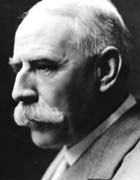 Take this example. The art music of the British brass band began slowly – just a handful of major works before 1939 largely composed for use in the National Brass Band Championships.
Take this example. The art music of the British brass band began slowly – just a handful of major works before 1939 largely composed for use in the National Brass Band Championships.
Some are now regarded as masterpieces of the medium – 'The Severn Suite', 'A Moorside Suite', 'Comedy', 'Pageantry' et al– and there was much more from the lesser creative figures who modelled their music on the 19th century romantic tradition.
The reaction to Elgar’s 'Severn Suite' in 1930 (right) was mixed. In The Brass Band Movement [Russell and Elliott, 1936], we read that one bandsman is reported to have much preferred to play the old operatic selections than to play the new ‘progressive’ music by Elgar.
Think about it
Think about that for a moment. Elgar was then the Master of the King’s music. He was the country’s leading ‘art’ composer, but by 1930 was already being thought of in the wider musical world as a something of a reactionary figure, whose music was redolent of the past rather a reflection of the present. He was the revered master of orchestral music and yet his music was considered rather too novel for that brass band traditionalist.
With the benefit of hindsight, it is possible to interpret this reaction in a number of ways. It could be viewed as symptomatic of the persistent institutional insularity of the brass band movement.
Revealing
It could reveal something of the position of the brass band within the wider cultural firmament. It could be used as an indicator of the way the music bands play has been valued in successive eras. You might even conclude that that nothing has changed very much.
I love the commented made to me a number of years ago, when I was planning to revive a long neglected work for performance from the Besses o’ th’ Barn Band archive when I was the MD in the early 1990s: ‘O we know that one, we won on it in the 1920s’. This was 1991!
Paul Hindmarsh




